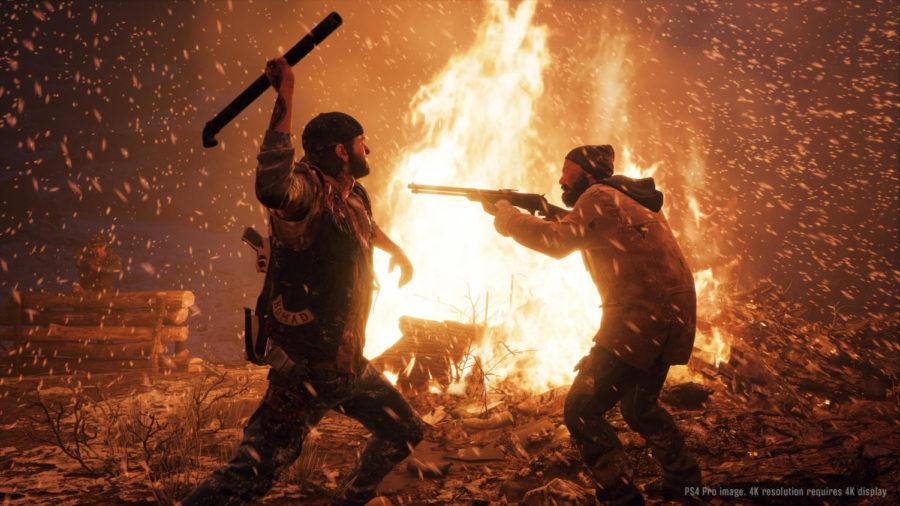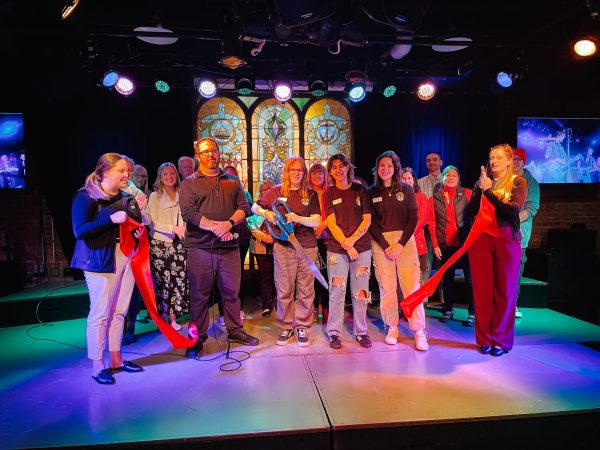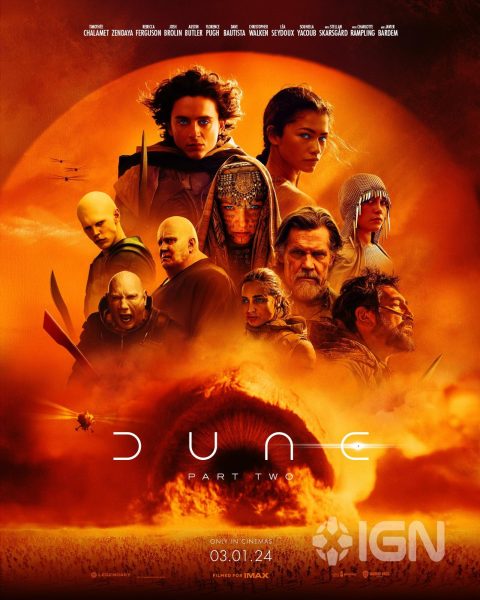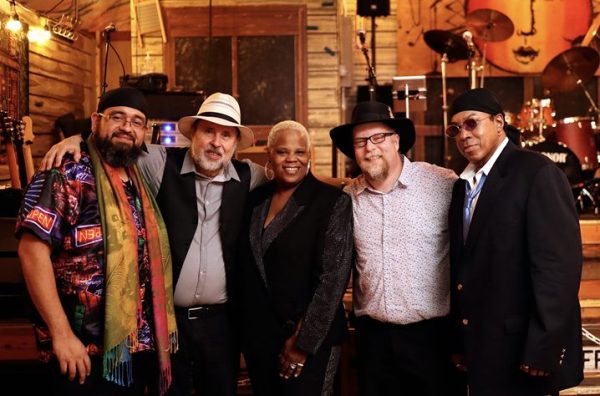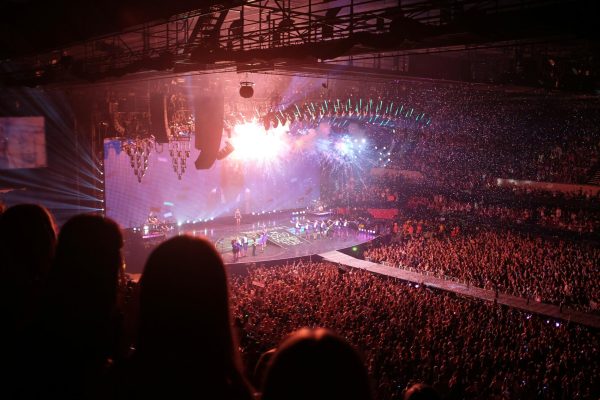Zombie-survival “Days Gone” is a solid game lacking personality
May 1, 2019
Sony’s newest zombie survival game, “Days Gone,” is a combination of several different games and ideas that results in a capable but somewhat bland experience.
In “Days Gone” you play as Deacon St. John, a biker gang member trying to survive in a post-apocalyptic Oregon after the outbreak of a zombie virus. Deacon, now surviving with his best friend, believes his wife was. Nearly two years pass when something finally happens to Deacon to reignites hope his wife is still out there somewhere, surviving.
The zombies are not zombies in “Days Gone,” instead more animal-like beasts called“Freakers.” A lot of the open-world activities have to do with dealing with Freakers in various ways, whether it be clearing out nests of them spread across a given area,or killing a horde of up to a thousand. Hordes were in fact the initial draw to this game, behaving similar to the thousand-zombie groups in the film “World War Z.”
There are various kinds of Freakers in the game. These include Newts (children turned Freakers), Swarmers (what the hordes are made up of), Breakers (big Freakers), and Screamers (Freakers that attract other Freakers). The Freakers all act uniquely, and are somewhat fascinating to watch. They are very animalistic, smelling everything and dragging people into nests, and each type behaves in its own way.
The Newts will not attack Deacon unless he is low on health or unless he intrudes on their territory, which is usually a rooftop they will retreat to. The Freakers have pretty good AI, searching for Deacon by smelling him and dodging bullets by flicking their heads and bodies from side to side.
Freakers are not the only enemies in this game however; there is wildlife and other humans to look out for. Animals “Days Gone” include huntable deer, as well as bears, cougars and wolves who will hunt you. Human enemies can set up ambushes for the player, camping outside of Deacon’s house. There are several different human factions, but they all act similarly.
Animal AI is realistic and interesting, but the human AI is where things begin to vary. During active gameplay, the human enemies tend to stay behind cover and shoot, slowly working their way towards you until they can charge you. The AI is generally good for them, but on some occasions the human enemies will make weird decisions that result in them dying. This does not heavily affect the game, however, since the meat of the gameplay is centered around the Freakers.
The true way to traverse the game’s world is via the motorcycle. Deacon’s bike is important in this game. You can not call for it to magically appear next to you — if you leave it across the map, you will have to walk all the way back to retrieve it. The bike can be upgraded and requires heavy amounts of maintenance such as giving it gasoline and repairing it with scrap you pick up from the environment.
Combat is decently fun and engaging. When having a gunfight with a group of human enemies, things feel standard and generic, but when shooting Freakers, it feels somehow new. This is especially true with the Hordes. The player has to run, shoot explosives, lay traps and plan out a whole scenario to kill hundreds or thousands of Freakers. It’s a high energy and intense portion of gameplay that makes the game shine. There are also stealth mechanics in the game, but nothing new or innovative.
The shooting of weapons ranges from good and somewhat satisfying, to un-fun and floaty. There isn’t enough impact when shooting certain weapons. The shooting feels especially bad when enemies don’t die after three or four shots, but it does hammer home the survival aspect of the game, forcing you to conserve ammo and resources.
The sole saving grace of the shooting is a slow-motion mechanic that can be activated while aiming. The melee combat is perhaps the best one-click melee in recent memory. The gore and true visceral of each impact of the weapon of choice is oddly satisfying and is likely how you will be taking out most lone Freakers.
To help the player find resources in the environment, Deacon has the ability to use his senses to scan the area around him to pinpoint where enemies, containers, and items are. It is never explained in-game how Deacon is able to do this, so it seems like the developers just saw it in other survival games and decided to throw it in.
There is a progression system that is quite interesting but just misses the mark due to lackluster upgrades. There are three standard skill trees, one for ranged combat, one for melee, and one for general survival. The player must kill enemies and complete objectives to gain enough experience to level up, and once a level is gained, the player gets one skill point which can be assigned to any of the available skills in the three skill trees.
The world of “Days Gone” is immersive and beautiful. The heavy blues that paint a dreary sky and the hard greens of the trees you drive past make the world feel comforting but appropriately sad. The wear and tear of the roads and the dirt paths make the world feel lived in and interesting. The decaying architecture from nearly two years of neglect shine through with broken windows and overgrowth all around, rainy weather makes everything even more beautiful and sad. The world is completely believable visually, barring some visual bugs every now and then.
There are towns that can be traveled to in the game, and the initial base of operations for Deacon and Boozer is a watchtower on top of a small mountain. Towns in Oregon feel like a realistic and natural progression of humanity after such a world-wide epidemic. Platforms built onto rocks and tree-house-like bridges and walkways enhance the pure survival element of this world. There is one camp players will visit that is basically is run like a prison, making the inhabitants work constantly just to be able to eat, showing that surviving is not necessarily living.
One area where the game fails is the audio. The sounds feel unnatural and oddly placed, with audio bugs all over. Sometimes characters will talk over each other and it isn’t clear if it is meant to be on purpose or not. The music playing during the more dramatic scenes make it feel like a dull action movie, but it conflicts because what you are seeing is truly good story telling.
There is good writing, but it’s sometimes overshadowed by the realism and bad acting. Melodrama and impatient characters can lead to unfulfilling conversations between rivals or friends.
Name aside, Deacon St. John is actually an interesting character. At first he seems unrelatable and almost insane because of how irrational he is, until considering his life as a biker before the apocalypse. After the Freaker outbreak, it is clear that these two years of regret have made Deacon a paranoid and depressed man. He often will talk to himself in the open world gameplay and during missions, narrating how he feels about a certain situation. Deacon is portrayed as morally confused, against killing people, but he will if he must. He doesn’t want anyone to die being torn apart and eaten alive by Freakers, but willing to let that happen if it means his or his allies’ survival. Deacon is truly a survivor, and playing as him and watching him react and develop through the story is one of the strongest parts of “Days Gone”.
“Days Gone” is a solid game, but doesn’t have enough going for it to make it unique in any way. The gameplay is standard and generic, the story is somewhat drawn out and over acted, but the world and the characters are where this game shines. The hordes are also a lot of fun visually and in terms of gameplay. The fatal flaw of “Days Gone” is its attempt to be a cross between many different games and movies, in the end lacking personality of its own. A solid mix of things from pop-culture and wholly unoriginal gameplay and story, “Days Gone” falls just short of excellence.
“Days Gone” – SIE Bend Studio
Verdict: 7/10

